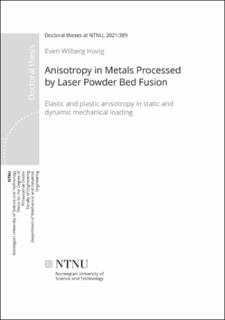| dc.contributor.advisor | Sørby, Knut | |
| dc.contributor.advisor | Azar, Amin | |
| dc.contributor.advisor | Boivie, Klas | |
| dc.contributor.author | Hovig, Even Wilberg | |
| dc.date.accessioned | 2021-12-13T07:52:55Z | |
| dc.date.available | 2021-12-13T07:52:55Z | |
| dc.date.issued | 2021 | |
| dc.identifier.isbn | 978-82-326-6691-1 | |
| dc.identifier.issn | 2703-8084 | |
| dc.identifier.uri | https://hdl.handle.net/11250/2833897 | |
| dc.description.abstract | This thesis is addressed to engineers and researchers working with powder bed fusion (PBF) additive manufacturing (AM) and provides insight into anisotropic mechanical properties for metals subjected to static and dynamic loading. Three common AM materials are investigated; Inconel 718, AlSi10Mg, and maraging steel grade 300. The thesis highlights the need to account for anisotropy when performing finite element analysis and provides methodology for determining anisotropic material models.
The focus is on PBF metals subjected to appropriate heat treatments commonly used in the industry. In the case of static loading the focus is on anisotropy caused by either preferred crystallographic orientation or alignment of inclusions, defects, or particles in the microstructure. In the case of dynamic loading, the focus has been on the contribution of surface roughness on fatigue life reduction.
The objective is to determine robust anisotropic material models in an efficient way. Digital image correlation (DIC) in combination with tensile testing is used to investigate the strain fields on rectangular tensile specimens in uniaxial tension.
This is complimented with microstructural evaluation with scanning electron microscopy and fractography with both optical and electron microscopy. For dynamic loading, a combination of experimental results and numerical results are analysed to benchmark build orientations in an effort to maximise fatigue life.
The main scientific contributions are presented in the form of six peer-reviewed articles published in international journals. The main contributions are summarized as:
• A method for determining anisotropic elastic constants using DIC and an optimisation algorithm in Matlab.
• A significant reduction of anisotropy in AlSi10Mg by elevating the process temperature in the PBF process.
• A description of how the melt pool boundaries causes anisotropy, and how this can be reduced by proper heat treatment.
• A methodology for benchmarking the fatigue life of AM components based on simple surface roughness measurements and numerical analysis.
• A methodology and software suite that can optimise part orientation in the PBF build chamber to maximise fatigue life.
• A novel fatigue test specimen that experimentally captures the effect of asbuilt surface roughness on fatigue life.
The contributions in this thesis can be applied by researchers and engineers when designing parts for manufacturing with AM. Anisotropic elastic constants can be used directly in finite element analysis to optimise design for AM. Future work can be done to improve the models for fatigue life estimation. The methodology for benchmarking orientations based on surface roughness are only valid when fatigue initiation stems from the as-built surface. Experimental fatigue data gathered with the novel test specimen can be used to further improve this methodology. | en_US |
| dc.language.iso | eng | en_US |
| dc.publisher | NTNU | en_US |
| dc.relation.ispartofseries | Doctoral theses at NTNU;2021:389 | |
| dc.relation.haspart | Paper 1: Hovig, Even Wilberg; S. Azar, Amin; Grytten, Frode; Sørby, Knut; Andreassen, Erik. Determination of Anisotropic Mechanical Properties for Materials Processed by Laser Powder Bed Fusion. Advances in Materials Science and Engineering 2018 ;Volum 2018.
https://doi.org/10.1155/2018/7650303
This is an open access article distributed under the Creative Commons Attribution License (CC BY 4.0) | en_US |
| dc.relation.haspart | Paper 2: Hovig, Even Wilberg; S. Azar, Amin; M'hamdi, Mohammed; Sørby, Knut. Mechanical Properties of AlSi10Mg Processed by Laser Powder Bed Fusion at Elevated Temperature. The Minerals, Metals & Materials Series 2020 s. 395-404 https://doi.org/10.1007/978-3-030-36296-6_37 | en_US |
| dc.relation.haspart | Paper 3: Hovig, Even Wilberg; S. Azar, Amin; Solberg, Klas; Sørby, Knut. An investigation of the anisotropic properties of heat-treated maraging steel grade 300 processed by laser powder bed fusion. The International Journal of Advanced Manufacturing Technology 2021 ;Volum 114. s. 1359-1372 https://doi.org/10.1007/s00170-021-06938-2 This article is licensed under a Creative Commons Attribution 4.0 International License (CC BY 4.0) | en_US |
| dc.relation.haspart | Paper 4: Hovig, Even Wilberg; S. Azar, Amin; Sunding, Martin Fleissner; Andreassen, Erik; Sørby, Knut. High cycle fatigue life estimation of materials processed by laser powder bed fusion. Fatigue & Fracture of Engineering Materials & Structures (FFEMS) 2019 ;Volum 42.(7) s. 1454-1466 https://doi.org/10.1111/ffe.12982 | en_US |
| dc.relation.haspart | Paper 5: Reiersen, Magnus; Hovig, Even Wilberg; Mhamdi, Mohammed; Diplas, Spyros; Pedersen, Mikkel Melters. A novel approach for enhancing the fatigue lifetime of the components processed by additive manufacturing technologies. Rapid prototyping journal 2021 https://doi.org/10.1108/RPJ-02-2020-0030 | en_US |
| dc.relation.haspart | Paper 6: Directional fatigue behaviour of maraging steel grade 300 produced by laser powder bed fusion. International Journal of Fatigue Volume 149, August 2021, 106229 https://doi.org/10.1016/j.ijfatigue.2021.106229 his is an open access article under the CC BY license (http://creativecommons.org/licenses/by/4.0/). | en_US |
| dc.title | Anisotropy in Metals Processed by Laser Powder Bed Fusion: Elastic and plastic anisotropy in static and dynamic mechanical loading | en_US |
| dc.type | Doctoral thesis | en_US |
| dc.subject.nsi | VDP::Technology: 500::Building technology: 530::Construction technology: 533 | en_US |

